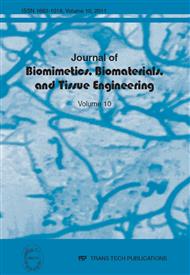p.1
p.7
p.17
p.25
p.43
p.55
p.67
p.75
Passive and Facilitated Transport of Cyanocobalamin (Vitamin B12) across Polymeric Membranes in Artificial Kidneys
Abstract:
Clearance of molecules by closed-circuit low-volume dialysis systems is limited by the accumulation of compounds in the dialysate and loss of the diffusion gradient. We sought to maintain dialysance of selected solutes by inducing “sink conditions” through the use of antibody-specific binding in the receiver compartment. Vitamin B12 was used as the test molecule since it is of clinically relevant size (molecular weight 1355 Da) and its clearance has been well-characterized for many dialyzer membranes. Using an in vitro haemodialysis model we perfused high-flux polymethylmethacrylate and low-flux polysulfone dialyzer membranes with known amounts of vitamin B12 through the intracapillary space. Clearances over time were calculated until equilibrium was reached within the fixed dialysate volume after 60 minutes. Anti-B12 monoclonal antibodies were then added to the receiver compartment reservoir. Under these sink conditions B12 clearance was restored, amounting to 77% and 118% of the integrated pre-equilibrium clearance for the high- and low-flux haemofilters, respectively. The magnitude of enhancement was such that the antibodies increased vitamin B12 clearance in low-flux dialyzers to levels observed in the high-flux devices. These studies demonstrate the feasibility of antibody-based sink conditions so as to promote substantial and highly selective solute clearance into small volume recirculating extracorporeal circuits.
Info:
Periodical:
Pages:
7-15
Citation:
Online since:
May 2011
Authors:
Price:
Сopyright:
© 2011 Trans Tech Publications Ltd. All Rights Reserved
Share:
Citation:


